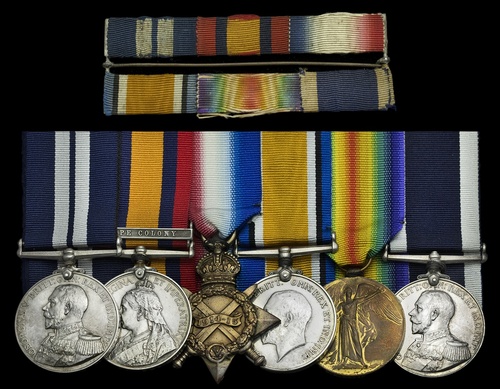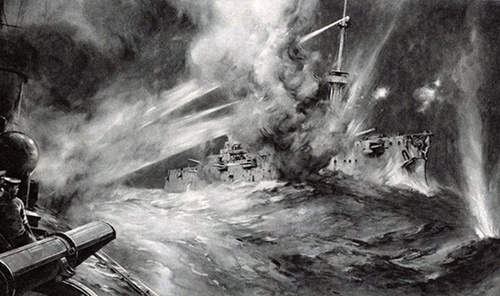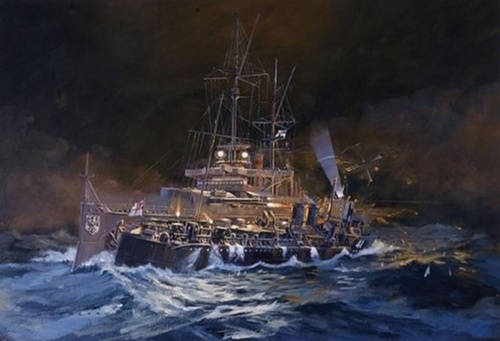Auction: 24003 - Orders, Decorations and Medals
Lot: 154
'Just before the impact, two shells had crashed through the screen of the bridge killing almost everyone there. Captain Trelawny miraculously escaped with only a scalp wound, though he was blown right off the bridge on to the main deck. The coxswain and one other seaman were later found in the wreckage. To be released the unfortunate seaman subsequently had to have his leg amputated without any anaesthetic, whilst lying amongst the tangled ruins of the bridge. The Spitfire was in a terrible state … '
Jutland 1916 - Death in Grey Waters, by Nigel Steel and Peter Hart, refers.
An exceptional - important - Battle of Jutland D.S.M. group of six awarded to Chief Petty Officer G. E. Smith, Royal Navy, who received multiple wounds during the severe mauling of the destroyer H.M.S. Spitfire
Prior to the 935-ton Spitfire's spectacular collision with the 20,000-ton German battleship Nassau - at a combined speed of 40 knots - Smith, the Torpedo Gunner's Mate, fired the torpedo that crippled the enemy cruiser Elbing
Rudyard Kipling was sufficiently impressed to describe Spitfire's ordeal in his Daily Telegraph battle reports in October 1916, possibly inspired by the 'ultimate souvenir' of them all, a 20-foot length of armour plating torn from Nassau's port side that was found on the destroyer's forward deck
Distinguished Service Medal, G.V.R. (203789 G. E. Smith, P.O., H.M.S. Spitfire 31 May - 1 June 1916); Queen's South Africa 1899-1902, 1 clasp, Cape Colony (G. E. Smith, Ord., H.M.S. Sybille); 1914-15 Star (203789 G. E. Smith, P.O., R.N.); British War and Victory Medals (203789 G. E. Smith, C.P.O., R.N.); Royal Navy L.S. & G.C., G.V.R., 1st issue (203789 G. E. Smith, P.O., H.M.S. Vivid), generally very fine or better (6)
D.S.M. London Gazette 15 September 1916. The original recommendation states:
'[He was the] Torpedo Gunner's Mate who fired the torpedo that sank the enemy cruiser. Although subsequently wounded in several places he insisted on carrying on with his duties.'
George Ernest Smith was born at Stratford-on-Avon on 17 November 1882 and entered the Royal Navy as a Boy 2nd Class in March 1899.
Embarked for South Africa in the cruiser H.M.S. Sybille in October 1900, he was among those landed from her for services in the Naval Brigade in Cape Colony on 9 January 1901 (Medal & clasp). This was as well, for a week later the Sybille was lost in heavy seas after striking a reef, and Smith was transferred to the books of the Blanche.
Back in home waters, he was advanced to Leading Seaman in February 1911 and, following a course at Vernon, to Petty Officer in January 1914. And it was in the same month - as a qualified Leading Torpedoman - that he joined the destroyer Spitfire.
Jutland Epic
Much has been written about the exploits of the Spitfire and her consorts in the 4th Destroyer Flotilla. Indeed, the courageous story of the torpedo boat destroyers at Jutland has attracted considerable commentary; Barry Bingham of the Nestor and Loftus Jones of the Shark - both sunk - were awarded Victoria Crosses, the latter posthumously.
For her own part, Spitfire just about survived, but as recounted in the following extract from The Jutland Honours, Chris Bilham's definitive work, it was a close run thing:
'At 23:15 hours, 4 DF [Destroyer Flotilla] was on a course almost due south at a speed of 17 knots, with Tipperary (Captain Wintour) in the lead, followed by Spitfire. When the German ships fired on Tipperary, the Spitfire immediately discharged a torpedo at them. It hit the light cruiser Elbing; she did not sink at once but, thus crippled, she was unable to get out of the way as battleships manoeuvred to avoid the torpedoes. She was rammed by the Posen and so badly damaged that she had to be scuttled. Spitfire fired a second torpedo which failed to find a target. She was hit several times, with heavy casualties amongst the after-gun's crew and the torpedo party.
Captain Trelawney then decided to go to the assistance of his hard-hit flotilla leader but, as he approached the blazing destroyer, Spitfire was observed by a large enemy ship which attempted to ram them. Spitfire's crew believed that this was a cruiser; not until after the war did they discover that it was in fact the 20,000 ton battleship Nassau. Trelawney manoeuvred desperately to escape the towering bows of the enemy. With Spitfire steaming at 27 knots, and the Nassau at not less than ten, the two ships collided head on, port bow to port bow. Lieutenant Bush, Spitfire's first lieutenant, left a vivid description of the impact:
"I can recollect a fearful crash, then being hurled across the deck, and feeling the Spitfire rolling over to starboard as no sea ever made her roll. As we bumped, the enemy opened fire with his foc'sle guns, though luckily, they could not depress them to hit us, but the blast of the guns literally cleared everything before it. Our foremast came tumbling down, our for'ard searchlight found its way from its platform above the fore-bridge down to the deck, and the foremost funnel was blown back till it rested neatly between the two foremost ventilation cowls, like the hinging funnel of a penny river steamboat. The enemy … surged down our port side, clearing everything before her; the boats came crashing down and even the davits were torn out of their sockets, and all the time she was firing her guns just over our heads. But none of her shells hit us, except two fired from her foc'sle guns just before ramming, which passed through the canvas screens round the bridge … With the exception of the Captain, the coxswain, and one seaman, who later on were extricated with much difficulty from the wreckage, everybody on the bridge was killed by these two shells. Eventually the cruiser passed down the length of us, cleared us astern and disappeared, leaving us still afloat, but drifting and in a somewhat pitiful state."
Fires broke out everywhere, trailing wires gave electric shocks to anyone going up to the bridge, and all the electric bells were ringing continuously. The surgeon, a nineteen-year-old medical student, working alone and without anaesthetic, amputated the leg of a seaman who was trapped in the wreckage of the bridge as the damage control parties fought fires all round them. He worked non-stop until the ship reached port thirty-six hours later.
The Spitfire faced a difficult voyage home. She had no charts, no wireless and no signalmen. There was a gaping gash in the bow; mess tables, collision mats, and shores were used to try and fill up the hole, but they were all washed inboard again time after time, and the wind and sea were fast rising. She steered to the westward at the utmost speed the bulkheads would stand - about 6 knots. By dawn on the 1st, the sea had risen a good deal and the wind was still freshening from the south-west, and about 0800 they had to abandon their course home and turn the ship head to sea. All store-rooms, shell-rooms and lower mess-decks forward being flooded, the crew began to get very anxious whether the fore bulkhead would stand the strain. The weather continued to deteriorate and they were on the point of firing distress rockets when, in the early hours of the 2nd, the weather moderated and they were able to bring her to dock at Jarrow.
Spitfire's casualties came to six killed and twenty wounded. A twenty-foot length of armour plating from the Nassau's port side was later found on Spitfire's deck, the ultimate souvenir of her remarkable encounter.'
As stated, Spitfire's story later appeared in Rudyard Kipling's Daily Telegraph reports in October 1916, in which is revealed the moment Smith collected his wounds. He and his torpedo crew, states Kipling, had 'nearly finished reloading when a shot struck the davit that was swinging out her last torpedo into the tube and wounded all hands concerned.'
In addition to his well-merited award of the D.S.M., Smith received accelerated promotion to Chief Petty Officer. Having then added the L.S, & G.C. Medal to his accolades in January 1917, he saw out the war in the destroyer Alarm and was finally pensioned ashore in November 1922; sold with copied research and a riband bar.
Subject to 20% VAT on Buyer’s Premium. For more information please view Terms and Conditions for Buyers.
Sold for
£3,800
Starting price
£1200











